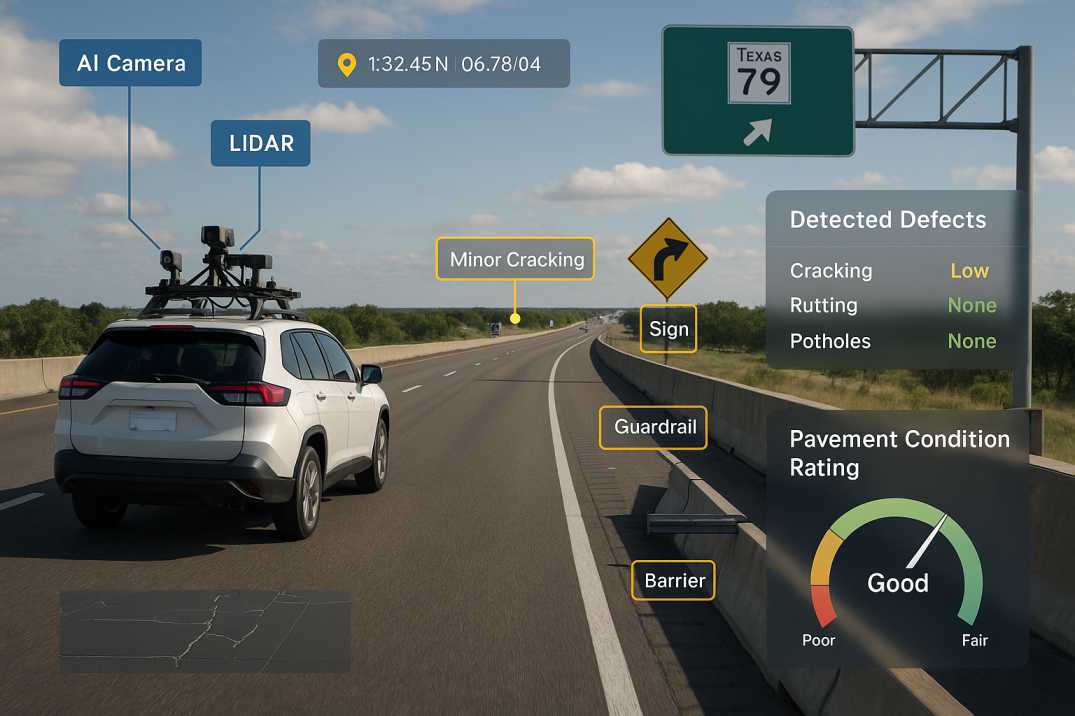Contact Us
RoadVision AI
Private Limited
Office No. 308 & 310, B Block
Ansal Chamber - 1, Bhikaji Cama Place,
Near Engineers India Limited (EIL) Bhawan, New Delhi - 110066
© 2024 | RoadVision AI | All rights reserved
Effective road inventory data collection in the USA is fundamental to maintaining safe, durable, and cost-efficient transportation infrastructure. With advancements in AI inventory inspection, digital road management systems, and GIS mapping, agencies across the United States are transforming how road assets are assessed and maintained. Whether for Department of Transportation (DOT) road inventory, pavement data collection, or road asset management USA, the methodologies are becoming increasingly digitized and standardized.
This blog outlines the best practices followed in the United States and highlights how AI-powered technologies are revolutionizing asset inspection, inventory management, and long-term infrastructure planning.

A road inventory is a comprehensive record of physical road assets, including pavement, signage, markings, culverts, guardrails, lighting systems, and more. It enables state DOTs, city agencies, and counties to:
The Federal Highway Administration (FHWA) requires agencies to maintain current and accurate road asset data, as outlined in 23 CFR Part 515, which governs transportation asset management plans (TAMPs).
The core elements in any road asset management USA strategy include:
Accurate pavement condition surveys are critical for identifying cracks, rutting, potholes, and surface deformations. Traditional manual inspections are now being replaced with automated and AI-powered data collection, reducing subjectivity and increasing coverage.
Explore AI-based surveys here: Pavement Condition Survey
Each state’s Department of Transportation follows the FHWA’s guidelines for collecting inventory data. These typically include:
The Highway Performance Monitoring System (HPMS) is one of the key data reporting systems that every state must comply with.
Modern tools like high-definition imaging, LIDAR, and AI-based algorithms are enhancing inspection accuracy. These technologies enable:
Geographic Information System (GIS) mapping is crucial for visualizing asset distribution and planning interventions. GIS maps support:
A centralized digital road management system allows transportation authorities to:
Use frameworks like the Model Inventory of Roadway Elements (MIRE) or the LRM (Linear Referencing Method) to ensure uniformity in data structure.
Invest in AI-powered mobile survey platforms that can capture high-definition road images and automatically detect defects using computer vision.
Centralize all road inventory data in a cloud system to ensure it is accessible, secure, and up-to-date. This enables easier collaboration between agencies and departments.
Use GPS and GNSS data tagging for every asset to maintain spatial accuracy. Pairing this with road GIS mapping USA systems enhances navigation, asset tracking, and analytics.
Schedule pavement condition surveys annually or bi-annually to monitor degradation and prioritize preventive maintenance.
Learn how AI makes this more efficient: Pavement Condition Survey
Include road safety audits as part of inventory assessments to identify high-risk zones, blackspots, and visibility issues.
Read more on this approach: Road Safety Audit
Data-driven approaches to budgeting ensure agencies can allocate funds effectively, prioritize critical repairs, and support long-term infrastructure sustainability.
Combine road inventory with traffic survey data to better understand usage patterns and deterioration rates.
Explore our AI-based traffic solutions: Traffic Survey
Equip field staff with mobile tablets, AI dashboards, and training on data collection standards to ensure consistent and accurate reporting.
Perform internal or third-party audits to validate asset records, identify discrepancies, and maintain compliance with DOT standards.
Emerging technologies are rapidly enhancing the accuracy and efficiency of road inventory collection:
All of these are being integrated into smart digital road management systems that support predictive maintenance and long-term planning.
RoadVision AI provides end-to-end solutions for road inventory inspection, pavement surveys, traffic analysis, and safety audits. With its cutting-edge AI-powered platform, RoadVision enables transportation departments to:
Modern road asset management USA demands high accuracy, speed, and compliance with federal and state regulations. With the integration of AI inventory inspection, digital road management systems, DOT road inventory standards, and road GIS mapping USA, agencies can maintain safer, smarter, and more cost-effective roads.
RoadVision AI is transforming infrastructure development and maintenance by harnessing AI in roads to enhance safety and streamline road management. Using advanced roads AI technology, the platform enables early detection of potholes, cracks, and surface defects through precise pavement surveys, ensuring timely maintenance and optimal road conditions. Committed to building smarter, safer, and more sustainable roads, RoadVision AI aligns with IRC Codes and also complies with U.S. road regulations and standards, empowering engineers and stakeholders with data-driven insights that cut costs, reduce risks, and enhance the overall transportation experience.
Organizations looking to implement the latest in inventory technologies should begin by evaluating their current data practices, investing in automation tools, and working with experienced digital partners.
Want to experience AI-powered road inventory first-hand?
Book a demo with us to explore how RoadVision AI can support your next project.
Q1. What is the role of AI in road inventory data collection?
AI helps in automating defect detection, improving data accuracy, and reducing survey times through real-time image and pattern recognition.
Q2. How often should pavement condition surveys be conducted?
Most DOTs conduct pavement condition assessments annually or bi-annually to ensure timely maintenance and data accuracy.
Q3. Is GIS mapping mandatory for road inventory in the USA?
While not mandatory in every state, road GIS mapping USA is widely adopted as a best practice for spatial accuracy and infrastructure planning.